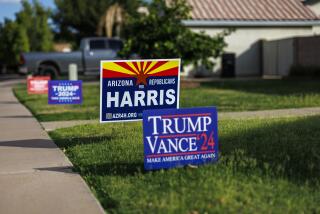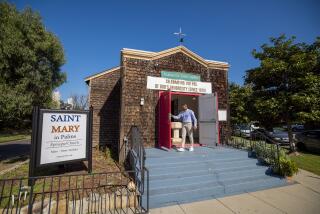Lone Protester Losing Battle to Block Church : Confrontation: He has spent 7 years trying to prevent the Jehovah’s Witnesses from building in neighborhood.
When the Park Hill congregation of the Jehovah’s Witnesses started hunting for a new home in Escondido more than seven years ago, church leaders anticipated some opposition from their new neighbors.
But they did not count on Jim Bohorquez. For the past three years, Bohorquez has led the fight to keep the Witnesses’ Kingdom Hall from being built in his quiet residential neighborhood on the southern outskirts of Escondido off Bear Valley Parkway.
For the record:
12:00 a.m. Oct. 4, 1991 For the Record
Los Angeles Times Friday October 4, 1991 San Diego County Edition Metro Part B Page 3 Column 3 Metro Desk 2 inches; 47 words Type of Material: Correction
Church Construction--A headline on a Wednesday article about Jim Bohorquez and his efforts to halt construction of a Jehovah’s Witnesses church in his residential neighborhood incorrectly stated the number of years that Bohorquez has been fighting the project. He has been participating in the neighborhood protest since 1989.
When the church leaders finally won a hard-fought battle for a county permit to build the church in 1989, all but a handful of the opponents turned to other pursuits, mollified by the changes made in the project or discouraged over the chances of ever winning the battle.
What started as an “aroused and angry populace” of more than 350 people opposed to a 500-seat sanctuary on a 10-acre site at Bear Valley Parkway and Encino Drive has now dwindled to one aroused and angry man: Bohorquez.
He continues to fight, eyeing each provision of the group’s permit requirements and standing watch to see that every condition is met. For a short time last weekend, he tasted victory.
When bulldozers moved onto the site last week and began carving up the landscape, Bohorquez was on the spot, waving a copy of the county’s use permit and crying “foul!”
To county inspectors and enforcement officers he called to the site, Bohorquez pointed out a county permit requirement for temporary fences to keep land-moving equipment out of what are supposed to remain open spaces. The fences weren’t there.
Bohorquez buzzed around the work site like an aroused bumblebee most of the week, finally succeeding in halting the grading operations Saturday. By Monday, the bulldozers were rolling again.
“There’s nothing more he can do except throw himself in front of the bulldozers,” one county inspector said of Bohorquez’s continued attack on the project, which is now in the land-clearing phase.
David Solomon, deputy county engineer, said Monday that “there were a few minor violations” at the church site, but added that all had been corrected before work was allowed to proceed.
Bohorquez sees the violation as “a deliberate attempt to evade the protections that the neighborhood fought so hard for” during packed county Planning Commission and Board of Supervisors’ sessions on the project in 1988 and 1989.
“My premonitions have come true,” Bohorquez said. “The church group gave up concessions in order to get this plan approved and now they are going to do just as they please.”
Bohorquez pointed out that seven oak trees with trunks over a foot in diameter had been removed, that a portion of the unfenced open space easement had been cleared.
Jim Chagala, county planning section chief, said that the permit language was very complicated and “subject to interpretation.” He said that removal of the trees was not prohibited under the use permit.
Chagala said that Bohorquez’s repeated calls to county staff members had led to an edict: “We told him that from now on he was not to bother our staff. He was to deal only with (Deputy Planning Director) Gerald Jamriska.”
Bohorquez fired back that Jamriska “is on a very well-timed two-week vacation” and went back to his telephone attack full force.
Joe Meyers, administrative aide to county Supervisor John MacDonald, said that MacDonald had not tried to mediate the differences between the church group and his angry constituent.
“We feel that he (Bohorquez) will not be satisfied with anything less than shutting the construction down and withdrawing the conditional use permit,” Meyers said. “There’s not much room for negotiation.”
Ken Chernish, spokesman for the Park Hill congregation, said that the church “has learned to live with Mr. Bohorquez, mainly because there isn’t much else we can do about it. He’s the only one left who is adamantly opposed to our building.”
At one point, Bohorquez became such a problem that the church’s lawyers sent him a sternly worded order to stay off the property or risk prosecution, Chernish said.
“We’ve done just about everything possible to make ourselves acceptable to the neighborhood,” Chernish said. “We have incorporated tile roofs and stucco in the design to fit into the architecture of the area at a cost much higher than we would normally spend.
“I don’t expect that Mr. Bohorquez will ever be satisfied or will ever stop fighting,” Chernish said with a sigh.
With that statement, Bohorquez agrees.
More to Read
Sign up for Essential California
The most important California stories and recommendations in your inbox every morning.
You may occasionally receive promotional content from the Los Angeles Times.










